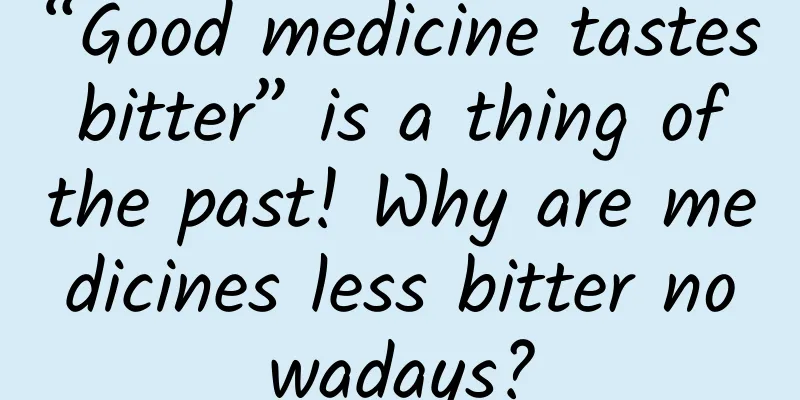“Good medicine tastes bitter” is a thing of the past! Why are medicines less bitter nowadays?

|
In the childhood memories of many people born in the 70s and 80s, the medicine they took was very bitter and pungent. This memory of mine is also deeply engraved in my mind. The taste of some medicines is still fresh in my memory, and I still shudder when I think of them. The first one is oxytetracycline tablets, a light earthy yellow tablet. At that time, the preparation technology was backward, and the tablets were often covered with powder and tasted bitter. When you eat it, you feel like you are "eating dirt" and it is difficult to swallow. I didn't know until I went to college that oxytetracycline belongs to the tetracycline class of antibacterial drugs, and it is not recommended for children under 8 years old. At that time, there was a shortage of doctors and medicines, so children with colds and fevers used this medicine. Many people born in the 1970s have "tetracycline teeth", which may be related to the use of this medicine when they were very young. Fortunately, my teeth did not become "tetracycline teeth". The second type is printed with "B什(pronounced zá) water" on the label (I later learned that its scientific name is complex vitamin B solution), which is packed in a 2L white plastic bucket. According to the old "barefoot doctors" in the countryside, children who don't like to eat may be lacking in B vitamins, and they can drink three small bowls of this "B什 water" every day. Maybe I didn't have an appetite when I was a child, so my parents often gave me this medicine, and I often vomited after drinking it. So, every time I had to drink it, I would run away. In fact, this B-what-water is probably produced by a small workshop. A small bowl of medicine is given for each meal, and the accurate dosage is out of the question. It is a typical case of irrational use of medicine. There are many bitter medicines, such as Niuhuang Jiedu Tablets and Huangliansu Tablets. It is said that people in the past could endure bitterness, so the bitterness of these medicines may not be a problem, but now thinking about it, it is still a bit nauseating. Scientific research shows that humans are most sensitive to bitterness, and bitterness is the most difficult to eliminate in the mouth and retains for a long time, so most people have a deep memory of bitter things. But I don't know when it started, but I feel that the medicine I take is not as bitter as before. Especially now, many of the medicines children take have the taste of candy, colorful and cute shapes. Compared with my childhood, I was so happy. So, why are the medicines now less bitter than before? Some people may ask, if the medicine is not bitter, does it mean that the effect is also reduced? It was not until I studied pharmacy that I realized that there are many scientific reasons for this, and good medicine does not have to taste bitter . Today, let me talk about this issue. 1. Application of drug flavoring excipients First, the application of pharmaceutical flavoring excipients has made great progress. To cover up the bitterness and odor of drugs, it is often necessary to add various flavoring agents and use various flavoring technologies, so that the drugs will not produce too many unacceptable tastes when they come into contact with taste buds, and improve patients' acceptance of drugs. In the past, there was a lack of corresponding materials and technologies in China, and the only way to cover up the bad smell of drugs was to add sucrose, honey or use sugar coating technology. Nowadays, various flavoring agents are used, including sweeteners, acidulants, fragrances, effervescent agents, bitterness inhibitors, etc., all of which are mature processes, simple and practical, and most of them are low-cost. The most widely used are sweeteners. However, since carbohydrate sweeteners such as sucrose, lactose, and maltitol may change the efficacy of drugs and affect the blood sugar of diabetic patients, their use is subject to various restrictions. However, the use of non-carbohydrate sweeteners such as sucralose, aspartame, stevioside, glycyrrhizin, etc. is becoming more and more widespread. Acidulants include lactic acid, succinic acid, tartaric acid, citric acid, citric acid, etc., which achieve the effect of correcting the taste by confusing the taste. Fragrances mainly refer to various flavors, both natural and synthetic, which interfere with the sense of smell. Effervescent agents are made up of acidic agents such as citric acid and malic acid and alkaline agents such as sodium carbonate and sodium bicarbonate based on the principle of acid-base neutralization. When they come into contact with water, a chemical reaction occurs to produce a large amount of carbon dioxide, which achieves the effect of correcting the taste by temporarily paralyzing the taste buds. 2. Development of drug flavor correction technology In recent years, drug flavor correction technology has made great strides, including coating technology, cyclodextrin inclusion technology, microcapsule microsphere technology, solid dispersion technology, etc. In layman's terms, these technologies are nothing more than using excipients to "dress" the drug, or embed the drug into the excipient, or wrap the drug with polymer materials to prevent the taste buds from directly contacting the drug, thus deceiving the taste buds and naturally achieving the effect of flavor correction. I still remember the sugar-coated tablets I ate when I was a child. As soon as the medicine was put into my mouth, a sweet taste appeared. The surprise lasted no more than 3 seconds. Then, after the sugar coating melted, the bitter taste of the medicine inside lingered in my mouth, leaving a shadow on my childhood. Now with the improvement of coating technology, it is rare for the coating to melt in the mouth. These new flavor correction technologies not only have the effect of covering up the original taste of the drug, but also have the effect of allowing some drugs to achieve sustained and controlled release, improving the efficacy of the drug and reducing adverse reactions. It can be said that it kills two birds with one stone. 3. Improvement of formulation technology With the development of science and technology, information technology and automation technology are increasingly being used in the design and production of drugs. Now, in order to cover up the bad smell of drugs and improve the effect of drugs, a variety of flavor correctors and flavor correction technologies are often used in combination. In addition, the quality control of drug production is becoming more and more stringent, and the phenomenon of oxytetracycline powder sticking to the surface mentioned at the beginning of the article has become less and less. 4. Application of taste correction evaluation methods In recent years, scientists have proposed to evaluate the taste-correcting effect of drugs and have invented a series of evaluation methods, such as asking volunteers to taste or smell the drug, using animals to test the bitterness of the drug, and using electronic noses and electronic tongues designed with artificial intelligence technology to evaluate the taste-correcting effect of drugs. 5. Personalization of drug design As competition in the pharmaceutical market intensifies, more and more pharmaceutical manufacturers are designing and improving the smell and appearance of drugs in a targeted manner. Some drugs are made with a special taste and appearance to improve patient acceptance and compliance, especially in the use of children, the elderly and women. For example, orange-flavored ibuprofen suspension and strawberry-flavored cefaclor dry suspension can give children the psychological hint of candy, arouse children's interest, increase acceptance, and reduce the difficulty of feeding medicine. Studies have shown that the taste, shape, and color of drugs may affect patients' attitudes and acceptance of drugs, and thus affect the efficacy. Therefore, personalized design of drugs is very important. Medicines are indeed not as bitter as they used to be, but this does not mean that the quality and effectiveness of medicines have declined. On the contrary, it is a reflection of the improvement of medicine quality and scientific and technological progress. One of the missions of us medical workers is to make "good medicine taste bitter" a thing of the past. About the Author Feng Huancun is a pharmacist and deputy director of the Department of Pharmacy of the Third Affiliated Hospital of Southern Medical University and a graduate industry mentor of Southern Medical University. He is also an expert in the Guangdong Provincial Science and Technology Advisory Expert Database, a standing member of the Guangdong Pharmaceutical Society's Pharmacy Popular Science Expert Committee, and a member of the Science Popularization Committee of the China Medical Education Association. He has presided over 5 provincial scientific research projects, including the Guangdong Provincial Science and Technology Plan Project. He has published 15 academic papers in research journals as the first author/corresponding author, including 4 SCI papers. He has obtained 1 national utility model patent and 2 software copyrights. He has participated in the editing of 3 monographs. He won 1 third prize in the Guangdong Pharmaceutical Society Hospital Pharmacy Science and Technology Award and the 2023 China Hospital Management Award Pharmacy Management Bronze Award. He has won the titles of Science Popularization Pioneer of the Children's Drug Professional Committee of the Chinese Pharmaceutical Society, Science Popularization Expert of the China Health Promotion Foundation, and Pharmacy Popularization Star of the Guangdong Pharmaceutical Society. |
>>: Overglaze vs. Underglaze: The Art and Safety of Tableware Selection!
Recommend
Baidu promotion video information flow advertising display style - Feed post-patch
Information flow advertising style - Post-feed pa...
Xiaofei Training Camp 10th issue Baidu Cloud download
Resource introduction of Xiaofei Training Camp 10...
Does nutrition have "density"? The 10 most nutritious fruits and vegetables worth eating in winter
Some foods can provide a lot of nutrition with ju...
Case review | Marketing strategy, execution and highlights of NetEase Yanxuan’s 411 anniversary event
When we talk about a company, it is no longer abo...
Why do "3 agents" have no water to drink? Scientists have discovered 14 reasons for failure
2025 is the year of agent explosion. Based on the...
Which industries are suitable for bidding for OCPC? Urgent, waiting online!
We all know that Baidu recently updated its backe...
A detailed account of the open and covert struggles between Apple and Microsoft over the years
On October 7, Microsoft held a new press conferen...
Is APP dead? Is mini program promotion coming?
On January 9, 2007, Apple CEO Steve Jobs unveiled...
How to improve ROI? Internet marketing combination methodology!
This article will focus on the general Internet m...
[Creative Cultivation Program] The amazing Nobel Prize-winning experience originated from the love of mathematics in youth
Author: The Nutcracker Studio The 2020 Nobel Priz...
4 pieces of online-purchased clothes in someone's closet tested positive! Remember to do this when receiving express delivery!
The situation of overseas shopping products has b...
Practical methods and operational thinking for lottery event planning
As an operational strategy, lottery has always be...
Does the “love at first sight” in “Wild Robots” really exist?
In the cartoon "Wilder Robots", the rob...
The chip with "organs" is here! It is also the "universal drug tester" of the future
Recently, the artificial blood vessel chip develo...
Mail Master Pro is coming to iOS for free this week
Starting this week, Mail Master Pro will be avail...









